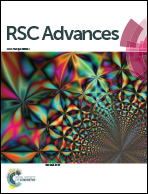Quaternary ammonium bearing hyper-crosslinked polymer encapsulation on Fe3O4 nanoparticles†
Abstract
The Gibbs free energy involved in the transfer of ions from water to a hydrophobic medium with ion-exchange sites changes the selectivity pattern expected from the electrostatic interactions. Oxyanions are less hydrated and, therefore, their exchange with more hydrated anions at the ion-exchange sites of a hydrophobic matrix in contact with aqueous solution is energetically more favorable. This gives rise to a possibility of separating the highly toxic monovalent oxyanions such as HCrO4−, MnO4−, TcO4− and ClO4− etc. by the Gibbs free energy of the transfer controlled anion-exchange process. In the present work, hydrophobic anion-exchange polymer encapsulation was anchored on Fe3O4 particles by a simple and reproducible method for studying the selectivity pattern. The choice of Fe3O4 nanoparticles (NPs) as the host matrix was based on their higher dispersion, larger surface area, and easy retrieval using an external magnetic field that is best suited for treating a large volume of an aqueous stream and developing sustainable technology. The anion-exchange polymer encapsulation was formed by first coating Fe3O4 NPs with (3-aminopropyl)triethoxysilane, and subsequently reacting these precursor particles in a sequence with poly(vinylbenzyl chloride) (PVBCl), 1,4-diazabicyclo[2.2.2]octane (DABCO), and 1,8-dibromooctane (DBO). Each step involved in the chemical treatments was monitored by C, H and N analyses. Energy dispersive spectroscopy (EDS) and Fourier transform infrared spectroscopy (FTIR) were used to confirm the expected chemical structure of the encapsulation on the Fe3O4 NPs. This sequence of chemical treatments resulted in the formation of hyper-crosslinked, hydrophobic, and high fixed positive charge density polymer encapsulation on the Fe3O4 NPs. The analyses of the images obtained from field emission scanning electron microscopy (FE-SEM) and transmission electron microscopy (TEM) indicated that the sizes of the Fe3O4 NPs were increased from 13 ± 3 nm to 33 ± 3 nm due to the formation of polymer encapsulation and inter-particle crosslinking. Although a very dilute solution and ultrasonication were used, there was a possibility of crosslinking between the particles. However, the thus encapsulated Fe3O4 NPs retained their superparamagnetic properties having a reasonably good magnetic saturation (30 emu g−1). The anion-exchange capacity was found to be 0.65 ± 0.03 meq g−1. The Fe3O4@PVB–DABCO–DBO particles exhibited a selectivity pattern corresponding to the Hofmeister series, i.e. the least hydrated anions were adsorbed preferentially. For example, the least hydrated representative TcO4− anions adsorbed quantitatively in the Fe3O4@PVB–DABCO–DBO particles from aqueous solutions such as ground water, seawater, and 0.5 mol L−1 HNO3 with efficiencies of 98%, 80% and 75%, respectively.


 Please wait while we load your content...
Please wait while we load your content...